THE LANDSCAPING SOLUTIONS BLOG
Welcome to our Blog. Inspiration, updates and industry trends from the team at Landscaping Solutions.
SUSTAINABLE GARDEN DESIGN - THE FUTURE OF LANDSCAPING
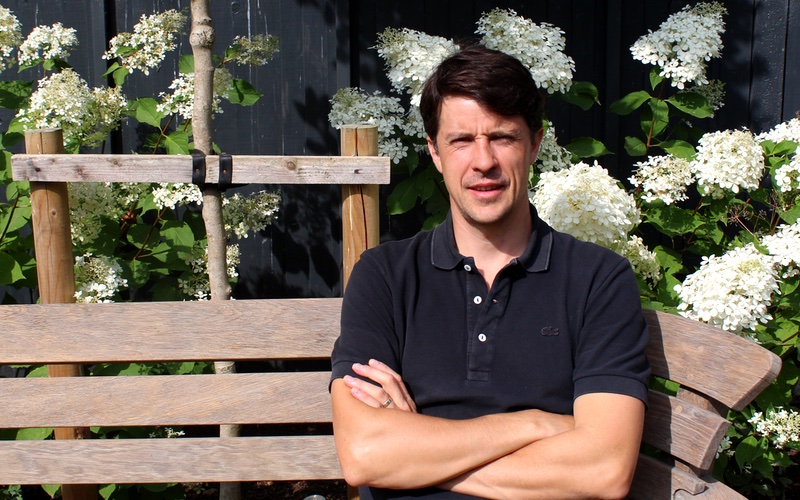
Ben West, Landscaping Solutions.
Garden designers and landscapers are in a unique position. We not only build gardens but bring an enormous pool of knowledge that influences the materials used, the plants chosen…and the wildlife that will visit them.
We’ll all take our own lessons from these lockdown weeks, but one of the precious things that they’ve given, rather than taken away from us, is time to think, to reassess and to create intent.
One of the most prevalent shared experiences of these weeks seems to be a greater appreciation of Nature, of its therapeutic value and how much we miss it when we cannot access it. Birdsong has become more noticeable, the air clearer. Butterflies seem more plentiful in the gorgeous weather.
Here in South West London, I’d venture that the leaves look a brighter green because of the lack of pollution.
Last year, the summit meeting at Futurescape concentrated on how the landscape industry might address climate change and I was on the podium as part of the discussion panel. When I looked around the meeting room, I saw impassioned and informed individuals seeking unity on the subject and itching for more progress within the industry.
It’s a matter that has been close to my heart for a long time. At Landscaping Solutions we began to increase the sustainability of the business some time ago. Seemingly small actions mount up to a much larger overall impact. But we believe there needs to be a more unified approach across the landscaping world.
Sustainability begins at ground level, before a spade is lifted. Putting it at the very beginning of a garden design project opens the opportunity for dialogue-rather than deciding on a material and us looking for a way to increase its sustainability through the supply chain or installation methods, it offers the chance to discuss materials and methods that the home-owner might not know to specify but which fulfil the brief.
Regenerative designs-those which add to the environment, rather than take away-are far more realistic, achievable and cost-effective for the average garden-owner than the slightly sterile designs that are so often to the fore in show gardens and which have such influence. We hope that trend-setters in the landscaping industry will push hard to move away from the unsustainable schemes that have been in vogue for so long.
This is an exciting time, full of hope. The Futurescape event made clear the hunger that members of the industry have for a different approach. There are designers around the country who put deep thought into how to make projects more sustainable, whether finding required stone onsite, using suppliers who propagate plants using peat-free compost, getting rid of waste products on Freecycle instead of sending them to the tip. There are many small steps that incrementally make a big difference, especially across an entire industry.
Here at Landscaping Solutions, we’re in the process of adding to our sustainability measures. Already, in sharing our knowledge of how to make gardens more attractive to wildlife, even with very small, easy-to-manage additions, we encourage garden-owners to widen the possibilities and create habitat that will sustain insect-life and the birds that feed on them.
For the future, we are looking to integrate an ecological assessment for each design and build. We’re examining ways to make the business zero-carbon or, at least, carbon neutral. We’re looking into the opportunities afforded by permaculture design. Can we create a suppliers’ carbon register, letting us align ourselves with suppliers with a good environmental approach? The possibilities are much wider than might immediately appear and many more ideas are under consideration.
What this means to home-owners is that they will know that their garden is not only contributing to the well-being of wildlife, giving their outdoor space an additional element to enjoy, but has made the least impact possible during its creation. It doesn’t have to mean a high-maintenance garden: minimising the necessity for power-driven maintenance tools is also a factor in the sustainable garden design.
For garden designers interested in working this way, Landscaping Solutions offers a sympathetic, enthusiastic partnership: solving problems, sharing knowledge, co-operating on plants and materials in a shared ethos, with no loss of quality or attention to detail in the build itself.
These lockdown weeks have given much food for thought to everyone, about our own lives, our working practices, the importance of personal contact, community and friends. In the context of gardens, they’ve shown us just how much we need a natural environment to recharge our batteries, to enjoy better health, to find serenity.
Now is the time to plan to act on this understanding. At Landscaping Solutions, we build award-winning gardens. We also want to build a better environment for us and our children.
We look forward to the exciting opportunities afforded by working with like-minded designers and suppliers. If you’d like to discuss the opportunities for your garden design, contact us at Landscaping Solutions now.
NATURE-FRIENDLY GARDEN DESIGN A SPECIALITY
Do you secretly long for a more Nature-friendly garden but fear the work involved? If you’re a garden designer, do you struggle to inject Nature-friendly elements into a brief because of clients fear it will result in an unwelcome workload?
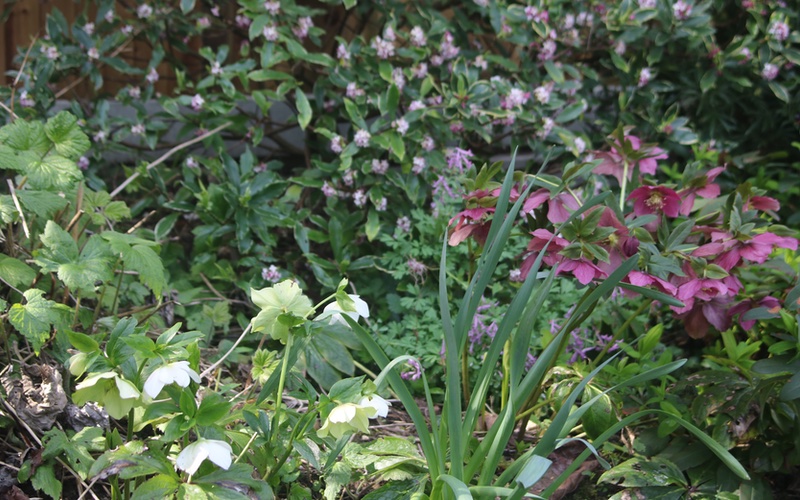
A low-maintenance corner of easy-care shrubs and perennials like the scented daphne (in background) and the hellebores in the foreground offer sustenance to insects early in the year. (Picture: Helen Gazeley)
Gardens are many things: a place to relax, to entertain, a play area for the kids, a haven, perhaps just somewhere for the cats to laze in the sun. Whatever it is, it certainly shouldn’t be a burden.
A garden is also where the natural world comes closest to our lives.
If we allow it to.
Garden-design briefs often veer towards pushing Nature away. Even as the merits of trees and plants in controlling pollution and producing cooling effects, the advantages of wildlife corridors across cities, and the physical and mental health benefits of looking out at a natural scene are increasingly understood and extolled, we lay more artificial grass, cut down trees, and even pave over entire gardens, generally in the interests of Low Maintenance.
Mea culpa!
The Outdoor Room
In part, it is the landscaping industry’s fault. We have spent the last two decades, since Groundforce took TV viewers by storm in the 1990s, describing the garden as an outdoor room, making it out to be an extension of our living space. And while we can certainly extend our day-to-day living into the garden, it is most certainly not a room.
What has been the effect of calling a garden an outdoor room? We suggest that it’s subtly altered expectations, and had a major impact on the look of gardens over the subsequent decades. If the garden is another room, it should look pretty much the same all year round and, if it’s a room, then all it needs is a quick dust, Hoover and tidy-up every so often, just like the lounge indoors.
In many ways this is ideal. Low maintenance is understandably one of the most frequent demands for a garden design, with mowing, weeding, leaf-blowing and pruning kept to an absolute minimum.
But what is missing?
Benefits of a Nature-friendly garden
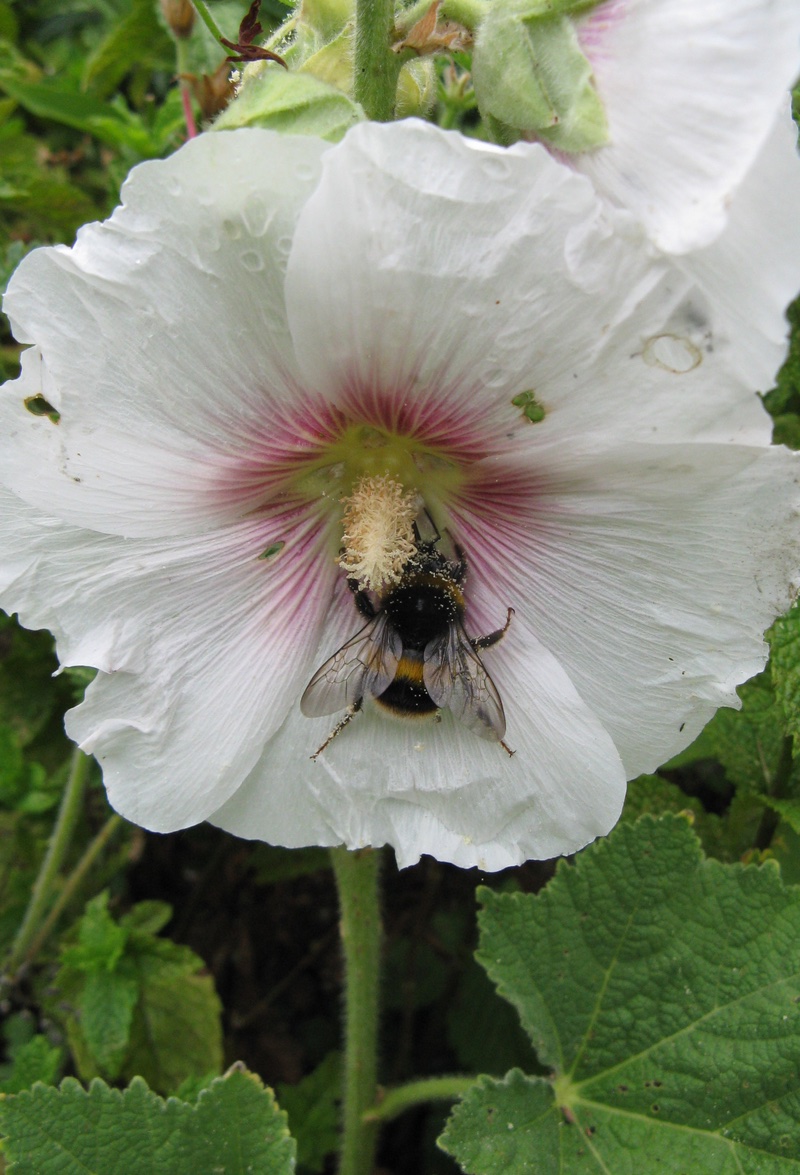
A single flower gives bees the chance to collect pollen where double flower sometimes don't. (Picture: Helen Gazeley)
A nature challenge run by The Wildlife Trusts in 2015 asked participants to do one “wild” activity every day for a month. Participants reported at intervals on how they felt. It turned out that even simple activities like feeding the birds and planting bee-friendly flowers made a difference, with an increase of 30% in participants reporting themselves in excellent health at the end of the challenge.
Other research has demonstrated how a view of nature reduces the need for pain-killers, aids healing, rests the mind and reduces negative emotions.
Children gain enormously from interaction with the natural world. In fact, research into human development portrays childhood as a time when we particularly want to explore it.
And none of the above is possible without the building blocks of a Nature-friendly garden that will attract the wildlife to give you the restorative and stimulating environment that will make a haven for you and a playground for your children.
The landscaping industry’s role?
At Landscaping Solutions we believe that we all have a responsibility towards Nature.
We feel privileged to be part of an industry which is uniquely placed as a bridge between the needs of our clients and the natural world. We can distance people from Nature, or we can create a manageable environment which harmonises with Nature.
If we look after it, it will repay us, with all the benefits listed above.
Client-friendly AND Nature-friendly
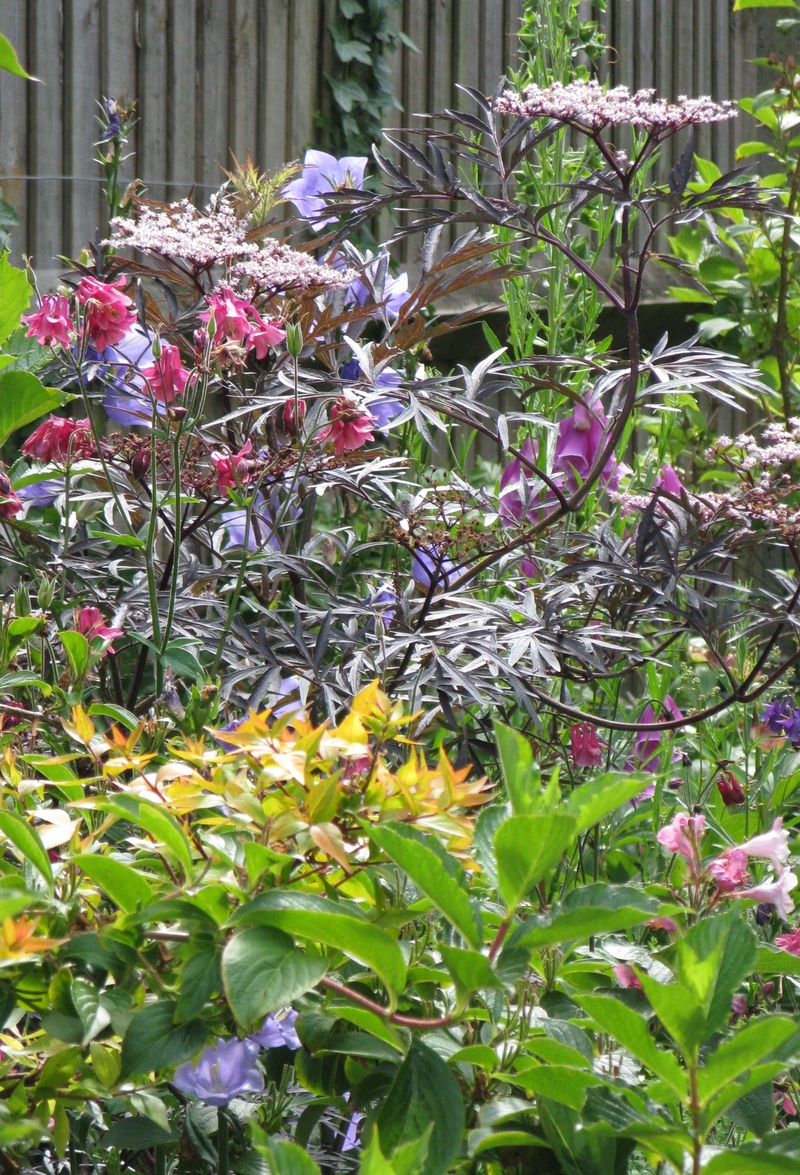
A mix of summer shrubs and self-seeders creates a nectar-rich corner. (Picture: Helen Gazeley)
What does this mean for your garden or, as a designer, your clients’ garden? At Landscaping Solutions, we’re not advocating creating a wilderness outside the back door. We have built award-winning gardens that major on high-quality hard landscaping, with very formal designs and minimalist planting. We’re not going to preach about what should and should be in your or your clients’ garden. However, we choose our materials and plants mindfully.
And this is where we can help. Most garden-design briefs allow plenty of room for nature-friendly elements creating regenerative garden designs that add too, rather than take away from, the environment. They may not be things that you immediately associate with a low-maintenance garden but, if properly installed, they require little attention while enhancing the design, bringing the pleasures of Nature closer to your window, and making a more sustainable design for local flora and fauna.
Here at Landscaping Solutions we have an excellent understanding of how to introduce tiny differences with a big impact, adding a Natural element and yet give you a living space that you can use as part of your daily life and not slave over.
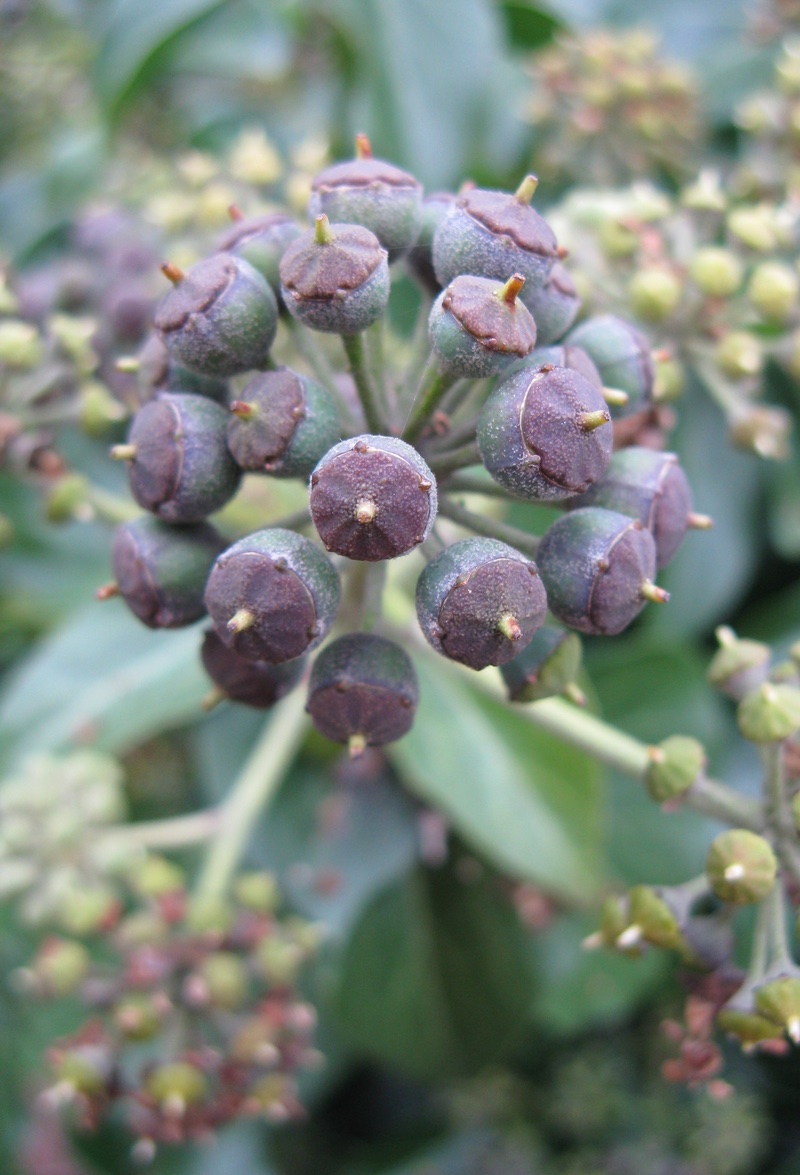
Ivy makes an ideal, easy-to-trim fedge (mix of hedge and fence) and strikingly structural fruit which feeds thrushes in winter. (Picture: Helen Gazeley.)
From choice of productive shrubs, trees and nectar-rich flowering plants that will attract and feed wildlife, choice of grasses and wildflowers for the lawn and minimum grass-cutting regimes, to the installation of safe ponds and small areas of locally appropriate habitat, we have plenty of tools in our toolbox to create a design that will give you an interesting, sustainable garden throughout the year.
We work sympathetically with designers who want to expand the Nature-friendly extent of designs. We can also provide a garden design service. Alternatively, if you would like to make some changes, however small, to your existing garden with a view to supporting wildlife and are wondering what you could reasonably do, we’re happy to advise.
For more information or an informal chat about options, contact Ben West.
STOP PRESS:
At Futurescape on 19th November, Landscaping Solutions’ Ben West will be taking part in the Summit at the end of the day.
A leading industry event, taking place at Sandown Park Racecourse, Surrey, Futurescape brings designers, landscapers and contractors together from all over the UK, creating a stimulating platform for industry debate. Ben will be asking exactly what are our responsibilities as an industry in creating outdoor spaces, and how can we reasonably fulfil them?